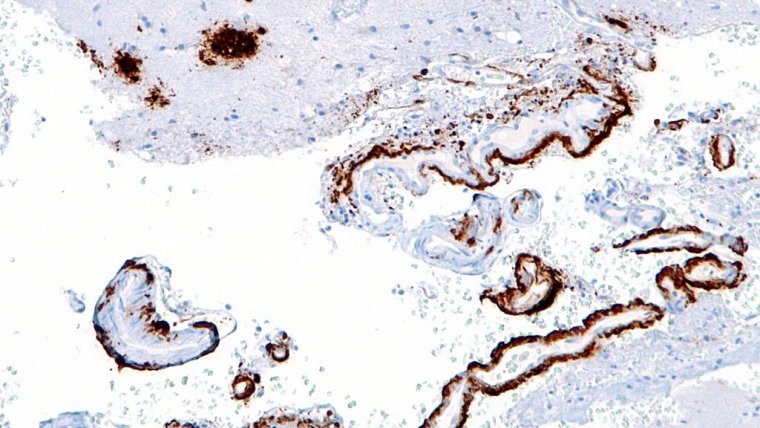| Health / Health News |
Alzheimer’s protein may have natural antibiotic role
NIH | JUNE 12, 2016
Alzheimer’s disease is a progressive neurodegenerative disorder that damages healthy brain cells. It causes the brain’s nerve cells to lose their ability to function and communicate with each other, and eventually die. Over time, this process destroys memories, causes personality changes, and makes it hard to perform daily activities.

Amyloid beta (brown) in senile plaques of the cerebral cortex (upper left of image). ![]()
One of the major hallmarks of Alzheimer’s disease is amyloid plaques that are found in between nerve cells. These plaques are made up of a small protein chain called beta-amyloid, along with other proteins and pieces of nerve cells. Beta-amyloid is believed to result from the abnormal processing of the amyloid precursor protein (APP). The biological purpose of beta-amyloid hasn’t been known.
Beta-amyloid has some features similar to a family of immune molecules called antimicrobial peptides, or AMPs. A team from Massachusetts General Hospital and Harvard Medical School investigated whether beta-amyloid might also have antimicrobial properties.
The team compared how bacterial infections progressed in the brains of genetically modified mice that either had too much or no beta-amyloid. Mice with excess beta-amyloid survived longer than the controls and had less bacteria in their brains. Mice lacking beta-amyloid (from the genetic removal of APP) died more often from infection.
Beta-amyloid also showed protective effects in C. elegans worms that were genetically altered to express human beta-amyloid. These worms lived longer than controls after being infected with the Candida albicans fungus. Cultured human brain cells infected with this fungus also had higher survival rates when they were altered to produce more beta-amyloid.
Experiments with fungal cells showed that beta-amyloid disrupted Candida’s ability to adhere directly to host cells—a mechanism necessary for infection. The microbes also clumped together in the presence of beta-amyloid. Both effects are similar to those seen with antimicrobial peptides. Further work revealed other similarities to AMP activity.
Electron microscopy showed that the microbes were entangled in beta-amyloid fibers extending from the surfaces of the fungal cells, suggesting an entrapment role for beta-amyloid. Electron microscopy of the mouse brains infected with bacteria also showed that the microbes were embedded in beta-amyloid fibers. The authors propose that beta-amyloid’s role in Alzheimer’s disease may result from dysregulation of normal immune system activity rather than abnormal processing of APP as previously believed.
YOU MAY ALSO LIKE


